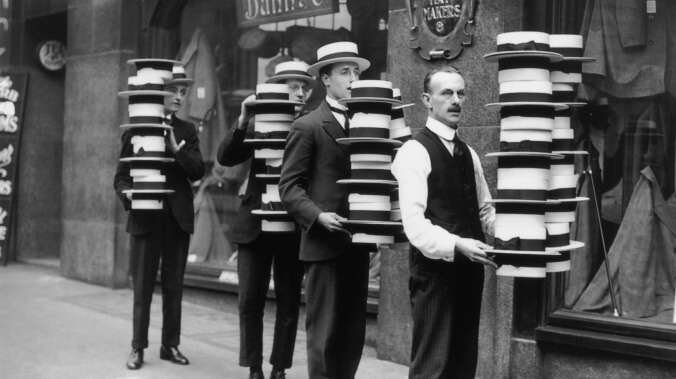This week’s entry: The Straw Hat Riot
What it’s about: A bizarre incident in 1922 when the fashion police were supplanted by fashion vigilantes, out for blood. Like wearing white after Labor Day, wearing a straw boater after September 15 was a faux pas in 1920s America, and it was common practice for teenagers to knock straw hats off people’s heads and stomp on them after that date. When, in 1922, a bunch of teenagers decided to start a few days early, things escalated quickly.
Biggest controversy: The date for “Felt Hat Day” (so called because felt hats were acceptable fall attire) somehow moved, for reasons that are unclear, from September 1st to the 15th. The tradition of stomping on hats past that day began among stockbrokers, but it was only done to fellow stockbrokers—being colleagues, it was seen as all in good fun, whereas destroying a stranger’s hat was seen as wanton destruction of property. But if there’s one thing teenagers can’t resist, it’s wanton destruction of property, and they soon got into the game, and the results caused enough chaos that the police often got involved. Newspapers would print warnings of the upcoming date at which men could wear straw hats only at their own risk.
But in 1922, things got out of hand. A bunch of teenagers in Manhattan decided to start the hat-smashing tradition two days early, on September 13. They started knocking off factory workers’ hats, but when they tried the prank on a bunch of dockworkers, the dockworkers were not having it. They fought back, and the brawl escalated to the point where it stopped traffic on the Manhattan Bridge. The police broke up the fight, but things escalated across the city, with gangs of teenagers armed with sticks, beating straw hat-wearing pedestrians. Some claimed a mob of as many as a thousand teenagers roaming Amsterdam Avenue.
Strangest fact: The police actually arrested one of their own during the riots. In a scene straight out of a Marx Brothers movie, a teenager knocked the hat off of a cop (identified here as Acting Detective Brundizo). When Brundizo gave chase, he was interrupted by a fellow officer, Sigmund Cohn. The kid got away, and Brundizo arrested Officer Cohn for “interfering with an officer in the discharge of his duty.” Cohn was able to convince the judge he didn’t realize the acting detective was a cop until he pulled out his gun and nightstick.
Thing we were happiest to learn: At least some of the young rioters got what was coming to them. The police took in a dozen or so stick-wielding boys; seven of them were under 15 and were not arrested. Instead their parents were called and the boys “were spanked ignominiously” by order of the lieutenant running the police station. Older teens citywide were arrested, and while many paid fines, none spent more than three days in jail.
Thing we were unhappiest to learn: The riot wasn’t all amusing hijinks. Several people were hospitalized after being attacked by the stick-wielding teenagers, and the police, slow to respond to the initial attacks, seemed to be overwhelmed by the mayhem based on the accounts here. And while the riots peaked in 1922, the hat-smashing fad continued, and continued to escalate into violence. In 1924, one man was murdered for wearing a straw hat. The violence finally died down in the ’30s, but not because people were fed up with being attacked. The straw boater fell out of fashion—after the 1929 stock market crash, the boater was seen as a “symbol of the irresponsible 1920s” and were rarely worn, even for boating. (Panama hats had also come into fashion, and eclipsed the boater as summer wear.)
Best link to elsewhere on Wikipedia: The initial brawl that spilled out onto the Manhattan Bridge began in Mulberry Bend, part of the notorious Five Points neighborhood (which, among other things, was the setting for Gangs Of New York). Thanks in large part to the efforts of photojournalist Jacob Riis, the buildings on Mulberry Bend itself (a curve in Mulberry Street) were demolished and turned into a park in 1897. But that didn’t stop hat-smashing no-good-niks from congregating there nearly 25 years later.
Further down the Wormhole: Wikipedia often uses current media outlets as sources, but for this article it had to go back to a newspaper that shuttered 96 years ago. The New York Tribune was founded by Horace Greeley in 1841, and was published for 83 years until, in 1924, it merged with competitor The New York Herald, which then became the New York Herald Tribune, which itself folded in 1966. The Tribune had been a family affair, with Whitelaw Reid taking over the paper from Greeley, and his son and daughter-in-law, Ogden Reid and Helen Rogers Reid, taking over from him. Helen ran the business side, and the combined paper was wildly profitable until the Great Depression hit. Ogden ran the editorial side, and late nights spent at a bar where reporters hung out led to issues with alcoholism (the hard-drinking newsman being a stereotype with a fair amount of grounding in truth in that era). Alcoholism can take a terrible toll both mentally and physically, and can lead to any number of related diseases attacking the liver, heart, lungs, brain, and elsewhere. But there’s also a disease that, if left unchecked, could cause alcoholism—auto-brewery syndrome, in which a person’s own gut bacteria produces alcohol at intoxicating levels. We’ll belly up to the bar next week.

